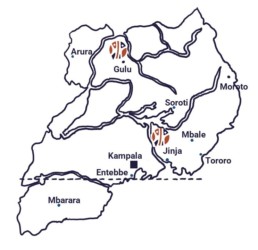Uganda
To propose projects that are adapted to the needs of communities, it is essential to understand the context in which they live. In our approach, we take into account the local culture, the history of the country and the socio-economic context in which the beneficiaries live. Our close collaboration with local partners helps to facilitate mutual understanding. This presentation of Uganda should give you some idea of the environment in which Omoana, its partners and beneficiaries work.
Uganda in brief:
Form of state: Republic
President: Yoweri Museveni
Geography: East African country bordering the Democratic Republic of Congo, Kenya, Rwanda, South Sudan and Tanzania
Capital: Kampala
Population: 48 million (2022)
Independence: 1962

A bit of history...
From 1894 to 1962, the country was officially recognised as a British protectorate. During the period following its independence in 1962, Uganda enjoyed good economic and social equilibrium. However, in the 1970s and 1980s, the country faced a period of civil and military instability, under the consecutive dictatorships of Milton Obote and the infamous Idi Amin Dada. This led to the destruction of a large number of infrastructures, particularly in the education and health sectors, and to the deaths of several hundred thousand people.
The situation has improved considerably since President Yoweri Museveni came to power in 1986. Despite his dubious reputation, it is clear that he has contributed, and continues to contribute, to the social and economic recovery of his country. However, inequalities are still very great, and the law banning political parties was only abolished in 2005.
In addition, between 1986 and 2006, civil conflicts continued in the north of the country between government forces and the Lord’s Resistance Army (LRA), whose main leaders are wanted by the International Criminal Court for war crimes. With the aim of seizing power and running the country according to the Ten Commandments of the Bible, the LRA has not hesitated to attack the civilian population, displacing 1.6 million people and kidnapping or killing tens of thousands of civilians, including around 60,000 children. The situation has stabilised since the truce signed in August 2006. The population has left the camps for the displaced and returned to their villages. However, the LRA continues to commit acts of violence in the Democratic Republic of Congo and Southern Sudan.
Geography
North of Lake Victoria, Uganda is a country of savannah-covered plateaux, where livestock farming, cotton, tea and above all coffee and fishing (in fresh water) are the main resources. The population, which is growing rapidly, is made up of a variety of groups (including the Baganda).
The climate is fairly favourable because it is located at altitude. On average, the country has two rainy seasons a year, making the soil fertile.
Omoana is active in the south of the country, in the Jinja region, which borders Lake Victoria, and in the north, in the Gulu region.
Socio-economic context
Despite 40% of the population living on less than a dollar a day, poverty seems to be on the decline in Uganda. More than 80% of the working population is employed in the agricultural sector: coffee is its main export income. However, the volatility of coffee prices is a constant source of insecurity for the people who earn their living from it. Although the country is self-sufficient in food, distribution is uneven. Malnutrition is also a common problem within communities. 29% of children under the age of 5 are chronically malnourished (Global Nutrition Report, 2015).
In addition to violence, the main causes of death are HIV/AIDS, malaria, pneumonia, tuberculosis and road accidents. Although the HIV/AIDS prevalence rate is already remarkably lower than it was twenty years ago, it remains very high (in 1990, the HIV prevalence rate among pregnant women calculated in antenatal clinics was close to 30% (Asingwire Narathius, The District Response Initiative on HIV/AIDS – ACTION RESEARCH, 2003)). HIV/AIDS is responsible for around ten thousand deaths every year. Such an epidemic therefore has a considerable economic and social impact. On the one hand, young adults affected by the disease are no longer able to provide labour or services. Secondly, more and more children are orphaned, while the elderly are left to look after their own children’s children.
Indicators
Population: 48 million (2022)
Life expectancy at birth: 63 years (2021)
Infant mortality rate: 30% (2022)
Birth rate: 37% (2022)
Urban population: 26% (2022)
Annual inflation: 7.2% (2022)
% of population living on less than $2.15/day: 42% (2019)
HIV/AIDS prevalence rate, 15 – 49 years: 5.2
The specific context of Northern Uganda
In northern Uganda, the population has been held hostage for many years by a civil war that has ravaged the region since 1986. The population has suffered greatly from the conflicts between government forces and the Lord’s Resistance Army (LRA), whose main leaders are wanted by the International Criminal Court for war crimes. In order to achieve their goal of seizing power and running the country according to the Ten Commandments of the Bible, they have not hesitated to attack the civilian population, displacing 1.6 million people and kidnapping or killing tens of thousands, including around 60,000 children.
Lasting peace is finally within reach, but the many years of war have left indelible scars. In addition to all the problems specific to Uganda, such as poverty, AIDS, malaria and malnutrition, the population of this region has suffered the violence of war: the rebels have massacred entire villages, leaving behind many orphans or, worse still, recruiting children as child soldiers. Many families have had to leave their home villages (and their gardens, often their only source of income) to settle in camps for displaced persons or near towns, in order to be safe from the rebels. Most of the children have been unable to follow a normal schooling and, at present, quality schools are rare.


